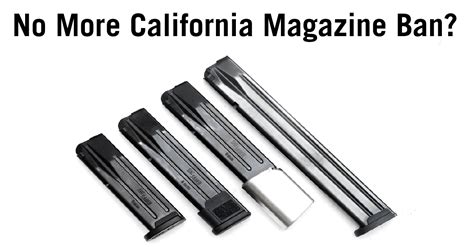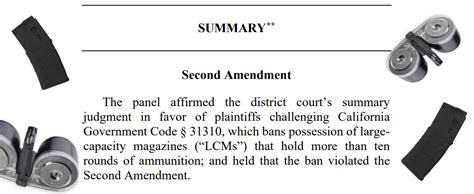
A Win At SCOTUS Could Result In The Removal Of Magazine Size Restrictions Nationwide
The Historic Ruling
On March 29th, 2019, US District Court Judge Roger Benitez (known as “Saint Benitez” in the California firearms community) for the Southern District of California issued an order striking down California’s 10 round magazine limit. It is especially significant that this order was issued in response to a request for summary judgement – which essentially says that the case is so clear that no further discovery or evidence needs to be presented. I’m sure that the California gun rights groups that made this requests considered it a “hail Mary” filing. Boy were they and everyone else surprised.
Judge Benitez’s ruling runs to 86 pages, so it is a challenge to summarize it here, but I’m going to try…..
Judge Benitez opens by citing several cases where 10 rounds were not enough to stop a home invader and where citizens were killed or injured as a result. He then documents how common home invasions have become, noting that the 2nd Amendment’’s core right is self defense. He points out that the mass shootings that the 10 round limit is supposed to mitigate are exceedly rare, while home invasions are much more common. He then notes that the law in question makes it a felony to prepare to exercise the right of self defense.
He then moves on to the plainifs motion – which builds on the Supreme Court’s Heller decision.
First he applies the “common use” test, stating that: “Millions of ammunition magazines able to hold more than 10 rounds are in common use by law-abiding responsible citizens for lawful uses like self-defense. This is enough to decide that a magazine able to hold more than 10 rounds passes the Heller test and is protected by the Second Amendment.” He admits that there likely are magazines large enough and uncommon enough to fall outside this protection – but that they would have to be far larger than 10 rounds. He goes on to say: “Under the simple test of Heller, California’s § 32310 directly infringes Second Amendment rights. It directly infringes by broadly prohibiting common firearms and their common magazines holding more than 10 rounds, because they are not unusual and are commonly used by responsible, law-abiding citizens for lawful purposes such as self-defense. “
He goes on to reject the argument that the state may regaulate firearms that are “too lethal”, as well as the argument that magazine limits are “longstanding” and therefore constitutional. He points out that a law can have been in existent for a long time and still be unconstitutional – and that magazine limits actually only go back as far as 1990 (and are therefore far from “longstanding”.
Moving forward, on page 38 of the ruling Judge Benitez writes “A law that implicates the core of the Second Amendment right and severely burdens that right warrants strict scrutiny.” That’s right, Judge Benitez’s ruling – if upheld – will require strict scrutiny to be applied to 2nd Amendment cases. (However, he also writes that the law would be equally unconstitutional under intermediate scrutiny.)
Additionally, Judge Benitez writes that “the (5th Amendment’s) Takings Clause prevents [California] from compelling the physical dispossession of such lawfully-acquired private property without just compensation.” Firmly establishing yet another reason why the law is unconstitutional.
He then spends multiple pages demolishing the states remaining arguments.
I simply must include this quote from page 62:
“ Perhaps the irony of § 32310 escapes notice. The reason for the adoption of the Second Amendment was to protect the citizens of the new nation from the power of an oppressive state. The anti-federalists were worried about the risk of oppression by a standing army. The colonies had witnessed the standing army of England marching through Lexington to Concord, Massachusetts, on a mission to seize the arms and gunpowder of the militia and the Minutemen—an attack that ignited the Revolutionary war. With Colonists still hurting from the wounds of war, the Second Amendment guaranteed the rights of new American citizens to protect themselves from oppressors foreign and domestic. So, now it is ironic that the State whittles away at the right of its citizens to defend themselves from the possible oppression of their State.”
In conclusion he issues this ruling:
“Accordingly, based upon the law and the evidence, upon which there is no genuine issue, and for the reasons stated in this opinion, Plaintiffs’ motion for summary judgment is granted.69 California Penal Code § 32310 is hereby declared to be unconstitutional in its entirety and shall be enjoined.”
The Appeal To The Ninth Circuit
It goes without saying that less than a week later, the California AG appealed to the 9th Circuit – no doubt expecting that this upstart judge would be overruled. However, on August 14th, 2020, the 9th Circuit Court of Appeals affirmed Judge Benitez’s ruling. However, injuctions both preventing further sales of magazines and the seizure of currently owned magazines remain in place.

Significantly, the 9th Circuit also affirmed that strict scrutiny is the standard of review for 2nd Amendment cases.
At this point, the California Attorney General Becerra had a difficult choice to make. Should he appeal to the 9th Circuit for an en banc hearing, there are two possible outcomes:
1) The ruling is upheld and he still loses, the California law is struck down and his choice would be an appeal to SCOTUS or accept the ruling. Should he except the ruling it would only be binding in the 9th Circuit. If he appeals and loses, a nationwide precedent would be set.
2) He wins at the en banc and the plaintiffs appeal to SCOTUS. He could do nothing to prevent this.
He probably thought long and hard about this – but decided that it was worth the “risk”, which after all, fell on the other restrictive states, mostly in the Northeast. On August 28, 2020, the last possible day, Attorney General Becerra requested an en banc hearing.
What Becerra could not know, but certainly wishes he did was that Supreme Court Justice Ruth Bader Ginsberg – a sure vote to affirm the legality of the California law – would pass away a mere 3 weeks later. Worse yet, she was replaced by a sure vote to strike the law, Amy Coney Barrett. If he cared about the Northeast states, he would drop his appeal, but there is no sign that he will do that.
So, at this point, this is where we stand. We await a hearing before an 11 judge panel of the 9th Circuit, and then a ruling several months later. If we win a third time, I highly doubt that Attorney General Becerra will appeal, but I could be wrong. The chances of winning are small and it would set a national precedent. If we lose we would absolutely appeal. In fact, an appeal and a win would be a huge 2A victory.
Would SCOTUS decide to hear the case? I think they would. In addition to the magazine issue itself, both the common use test and the level of scrutiny are in the balance. In any case, we shall see…...
Resources (All PDF Downloads):
FAQ for this case
Judge Benitez’s ruling
9th Circuit’s Ruling
On March 29th, 2019, US District Court Judge Roger Benitez (known as “Saint Benitez” in the California firearms community) for the Southern District of California issued an order striking down California’s 10 round magazine limit. It is especially significant that this order was issued in response to a request for summary judgement – which essentially says that the case is so clear that no further discovery or evidence needs to be presented. I’m sure that the California gun rights groups that made this requests considered it a “hail Mary” filing. Boy were they and everyone else surprised.
Judge Benitez’s ruling runs to 86 pages, so it is a challenge to summarize it here, but I’m going to try…..
Judge Benitez opens by citing several cases where 10 rounds were not enough to stop a home invader and where citizens were killed or injured as a result. He then documents how common home invasions have become, noting that the 2nd Amendment’’s core right is self defense. He points out that the mass shootings that the 10 round limit is supposed to mitigate are exceedly rare, while home invasions are much more common. He then notes that the law in question makes it a felony to prepare to exercise the right of self defense.
He then moves on to the plainifs motion – which builds on the Supreme Court’s Heller decision.
First he applies the “common use” test, stating that: “Millions of ammunition magazines able to hold more than 10 rounds are in common use by law-abiding responsible citizens for lawful uses like self-defense. This is enough to decide that a magazine able to hold more than 10 rounds passes the Heller test and is protected by the Second Amendment.” He admits that there likely are magazines large enough and uncommon enough to fall outside this protection – but that they would have to be far larger than 10 rounds. He goes on to say: “Under the simple test of Heller, California’s § 32310 directly infringes Second Amendment rights. It directly infringes by broadly prohibiting common firearms and their common magazines holding more than 10 rounds, because they are not unusual and are commonly used by responsible, law-abiding citizens for lawful purposes such as self-defense. “
He goes on to reject the argument that the state may regaulate firearms that are “too lethal”, as well as the argument that magazine limits are “longstanding” and therefore constitutional. He points out that a law can have been in existent for a long time and still be unconstitutional – and that magazine limits actually only go back as far as 1990 (and are therefore far from “longstanding”.
Moving forward, on page 38 of the ruling Judge Benitez writes “A law that implicates the core of the Second Amendment right and severely burdens that right warrants strict scrutiny.” That’s right, Judge Benitez’s ruling – if upheld – will require strict scrutiny to be applied to 2nd Amendment cases. (However, he also writes that the law would be equally unconstitutional under intermediate scrutiny.)
Additionally, Judge Benitez writes that “the (5th Amendment’s) Takings Clause prevents [California] from compelling the physical dispossession of such lawfully-acquired private property without just compensation.” Firmly establishing yet another reason why the law is unconstitutional.
He then spends multiple pages demolishing the states remaining arguments.
I simply must include this quote from page 62:
“ Perhaps the irony of § 32310 escapes notice. The reason for the adoption of the Second Amendment was to protect the citizens of the new nation from the power of an oppressive state. The anti-federalists were worried about the risk of oppression by a standing army. The colonies had witnessed the standing army of England marching through Lexington to Concord, Massachusetts, on a mission to seize the arms and gunpowder of the militia and the Minutemen—an attack that ignited the Revolutionary war. With Colonists still hurting from the wounds of war, the Second Amendment guaranteed the rights of new American citizens to protect themselves from oppressors foreign and domestic. So, now it is ironic that the State whittles away at the right of its citizens to defend themselves from the possible oppression of their State.”
In conclusion he issues this ruling:
“Accordingly, based upon the law and the evidence, upon which there is no genuine issue, and for the reasons stated in this opinion, Plaintiffs’ motion for summary judgment is granted.69 California Penal Code § 32310 is hereby declared to be unconstitutional in its entirety and shall be enjoined.”
The Appeal To The Ninth Circuit
It goes without saying that less than a week later, the California AG appealed to the 9th Circuit – no doubt expecting that this upstart judge would be overruled. However, on August 14th, 2020, the 9th Circuit Court of Appeals affirmed Judge Benitez’s ruling. However, injuctions both preventing further sales of magazines and the seizure of currently owned magazines remain in place.

Significantly, the 9th Circuit also affirmed that strict scrutiny is the standard of review for 2nd Amendment cases.
At this point, the California Attorney General Becerra had a difficult choice to make. Should he appeal to the 9th Circuit for an en banc hearing, there are two possible outcomes:
1) The ruling is upheld and he still loses, the California law is struck down and his choice would be an appeal to SCOTUS or accept the ruling. Should he except the ruling it would only be binding in the 9th Circuit. If he appeals and loses, a nationwide precedent would be set.
2) He wins at the en banc and the plaintiffs appeal to SCOTUS. He could do nothing to prevent this.
He probably thought long and hard about this – but decided that it was worth the “risk”, which after all, fell on the other restrictive states, mostly in the Northeast. On August 28, 2020, the last possible day, Attorney General Becerra requested an en banc hearing.
What Becerra could not know, but certainly wishes he did was that Supreme Court Justice Ruth Bader Ginsberg – a sure vote to affirm the legality of the California law – would pass away a mere 3 weeks later. Worse yet, she was replaced by a sure vote to strike the law, Amy Coney Barrett. If he cared about the Northeast states, he would drop his appeal, but there is no sign that he will do that.
So, at this point, this is where we stand. We await a hearing before an 11 judge panel of the 9th Circuit, and then a ruling several months later. If we win a third time, I highly doubt that Attorney General Becerra will appeal, but I could be wrong. The chances of winning are small and it would set a national precedent. If we lose we would absolutely appeal. In fact, an appeal and a win would be a huge 2A victory.
Would SCOTUS decide to hear the case? I think they would. In addition to the magazine issue itself, both the common use test and the level of scrutiny are in the balance. In any case, we shall see…...
Resources (All PDF Downloads):
FAQ for this case
Judge Benitez’s ruling
9th Circuit’s Ruling









